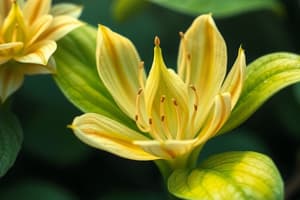Podcast
Questions and Answers
What is the primary function of a seed?
What is the primary function of a seed?
- To produce flowers
- To synthesize proteins
- To carry plants over periods unfavorable for growth (correct)
- To carry out photosynthesis
What is the result of double fertilization in seed development?
What is the result of double fertilization in seed development?
- Formation of a zygote and a primary endosperm nucleus (correct)
- Formation of two zygotes and two primary endosperm nuclei
- Formation of two zygotes and a primary endosperm nucleus
- Formation of a zygote and two primary endosperm nuclei
What is the correct sequence of events in seed development?
What is the correct sequence of events in seed development?
- Zygote nucleus divides, then embryo develops, then endosperm develops
- Endosperm develops, then embryo develops, then zygote nucleus divides
- Endosperm develops, then zygote nucleus divides, then embryo develops (correct)
- Zygote nucleus divides, then endosperm develops, then embryo develops
What is the characteristic difference between seeds of monocotyledonous and dicotyledonous plants?
What is the characteristic difference between seeds of monocotyledonous and dicotyledonous plants?
What is the primary function of the nucellus in the early stages of seed development?
What is the primary function of the nucellus in the early stages of seed development?
What is the term for the process by which animals, including humans, help disperse seeds?
What is the term for the process by which animals, including humans, help disperse seeds?
Which type of seeds often has endosperm persisting as a food reserve?
Which type of seeds often has endosperm persisting as a food reserve?
What is the term for the food storage tissue that persists in seeds of sugar beet and a few other species?
What is the term for the food storage tissue that persists in seeds of sugar beet and a few other species?
What is the function of the cotyledons in seeds that store food in the endosperm?
What is the function of the cotyledons in seeds that store food in the endosperm?
What is the term for the scar left on the seed where it broke from the stalk or funiculus during harvesting?
What is the term for the scar left on the seed where it broke from the stalk or funiculus during harvesting?
Study Notes
Seed Development and Structure
- Seeds provide a mechanism for plants to carry over periods unfavorable for growth, maintain a reserve supply of potential plants, and disseminate plants.
- Seeds ensure the renewal or continuance of plant populations, and many animals, including humans, cooperate in this process.
Embryo Development
- The embryo develops from the zygote and the seed coat develops from the integuments of the ovule.
- Double fertilization involves the fusion of egg and sperm nuclei to form a zygote nucleus and the fusion of polar nuclei with a second sperm nucleus to form a primary endosperm nucleus.
Seed Formation
- The zygote nucleus remains quiescent for a short time, while the primary endosperm divides rapidly and forms the endosperm tissue.
- The zygote nucleus then divides, resulting in a file of 4-8 cells, with the basal cell elongating and pushing the other cells into the endosperm.
- Further divisions result in a globular stage, then a heart-shaped stage after the two cotyledons develop, and finally into a mature embryo surrounded by a seed coat.
Monocotyledonous and Dicotyledonous Plants
- The main distinction between seeds of monocotyledonous and dicotyledonous plants is the occurrence of one or two cotyledons, respectively.
Nucellus, Endosperm, and Integuments
- The nucellus, endosperm, and integuments undergo changes characteristic of the plant group during embryo development.
- In most plants, the nucellus and endosperm are only required for initial stages of development and are used up as a nutritive source.
- In some plants, the endosperm persists as a food reserve, and in monocotyledonous plants, it often persists in seeds as the primary food source during germination.
Kinds of Seeds
- Seeds of angiosperms differ in two ways: they have one or two cotyledons and store food either in the embryo, in the endosperm, or more rarely, in nucellar tissue.
- Food stored in the embryo is conveyed to meristematic regions through vascular tissues, while food stored in the endosperm is absorbed through epidermal cells.
Examples of Seeds
- The common bean is an example of an exalbuminous seed, with a fruit that is a pod containing seeds with a hilum, micropyle, and raphe.
- In some cases, the cotyledons become specialized to act as absorbing organs, such as the scutellum in grasses.
Studying That Suits You
Use AI to generate personalized quizzes and flashcards to suit your learning preferences.
Description
This quiz covers the role of seeds in plant reproduction, dissemination, and population renewal. Learn about the significance of seeds in ensuring the continuation of plant populations.



